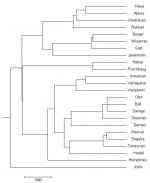Yes it is, but if it wasn't we wouldn't have all this fun here, hehe.
I don't think few clergy and civil workers can make a difference how language sounds. It might be the case that records of spoken language in spain are misleading. What I mean is that most records, from the past, of spoken language are from big cities where. This is the language of educated elite, which in spain case, was influenced a lot by germanic speaking tribes invading in middle ages. Mind that way back 90% people lived in villages. But the records how spanish was pronounced there are not existant.
Previous differences in f, v,b, j, might be of germanic way to speak spanish.
/.../
Here is a nice explanation about loss of sounds. What happens if english is imposed on Italians or French speakers? The sound H is dropped immediately, especially at the beginning of a word.
The sound shifts, the sound laws need big events to happen. People don't drop sounds or change them just because. Usually the big event is when two different languages are imposed on population, after invasion or migration for example. Make native Italians, Chinese, Indians, etc speak english and you will immediately see their local sound laws in action.
I agree as a whole, but :
germanic languages or people seam have had very light influence on spanish, castillan or other -
castillan :
V >> B /b/,/[FONT=Times New Roman, serif]β[/FONT]/ evolution found in France too (basque, gascon, languedoc → south auvergant + south limousin → Rhone valley eastward AND north corsican !
Ancient C /k/>>/tch/>>/sh/, J /y/>>/dj/,/zh/ gave /[FONT=Times New Roman, serif]χ[/FONT][FONT=Times New Roman, serif]/
? jota ? in castillan, close to germanic 'ch' – the Spanisuh court had the french or catalan pronounciation /sh/zh/ about the XV/XVI centuries as believe, turning into only /sh/ after, [/FONT]
[FONT=Times New Roman, serif]but in the North Central of Spain I think the evolution → /[/FONT][FONT=Times New Roman, serif]χ[/FONT][FONT=Times New Roman, serif]/ was begun already[/FONT][FONT=Times New Roman, serif] – in Western France we find a similar one : CH /sh/ >> /?h/ the palatal taking a more back position, between the germanic ichlaut '?' and a more low velar /[/FONT][FONT=Times New Roman, serif]χ[/FONT][FONT=Times New Roman, serif]/ - it took place in south Poitou, Aunis, Saintonge and Guyenne (P?rigord)-North Gascogne (Bordeaux surroundings) in a previous Wascon and territory & after the Aquitanian province - [/FONT]
F- > H- is an evolution we find in France in gascon dialect – it was pronounced /h/ or /[FONT=Times New Roman, serif]χ[/FONT]/ yet not long ago in N-E leones dialect (Cantabria) and N-W aragones -
S pronounced in various ways going closer to SH without influence of the phonetical environment – it 's /sh/ in basque -
when people learn a new language they very often simplify it (for there are some ? strange ? sounds for them) – they do stronger yet for grammar – articulation habits are very strong and can operate centuries after if the population don't change too much – there are based on collective habits for the most but maybe in some way to genetic heritage (contradicting the ? pure ? structuralists ?) - so in pronounciation things aren't always turning simpler : strange sounds can be dropped out but substrate evolution can work at last on the kept ones (even already transformed) according to the local habits -
here we can differenciate 'accent' and 'dialect' – accent plays on phonating execution of sounds when it don't change the PHONOLOGIC value or when this pronounciation don't create too much lexical confusion – it's the case with the various spanish 'S' and 'V'/'B'-
but when by instance we consider F >> H/- the learners take the new pronounciation as they learn it and will no more pronounce back F because this result: /h/ or /-/ is too far from /f/ in their mind – 'F' phonologically is very different from ? nothing ? or even /h/ - (etymology isn' t the favourite sport among folks) -
to go back to the topic, it's almost sure that a common factor played on basque language and castillan latin language (and S-W France romance languages), and the North Castile people passed NOT ALL ITS HABITS but gave some acquired deformations to the people of Central and South Spain when they swept the Muslims out (Reconquista) – Castillan dialects and others romance dialects of Iberia seam showing complicated crossed influences I find very uneasy to untangle – but Portugues differenciates very well from the region surroundings Vasconia and get closer to catalan and “normal” occitan spite of the distance -


